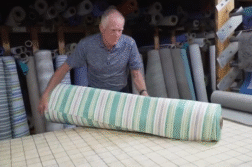ORLANDO, Fla. (Ivanhoe Newswire) — Whether it’s in the back, head, neck or knees … chronic pain affects nearly 100 million Americans and can interfere with daily living. Many have tried medications, therapies, vaccines and even surgery to cope and some have found temporary relief. While it might not sound appealing if you are aching, experts say certain forms of exercise will more readily get people back on their feet.
Meegan Descheneaux said, “I swam in the Hudson a mile. I biked 25 miles on my bike, and then I ran a 10k.”
These are all things Meegan never thought she’d do again as an adult. Growing up she was active in sports and dance, until chronic lower leg pain slowed her down. She knew exercise was critical to her recovery, but was never exactly sure what would work best.
Meegan told Ivanhoe, “A lot of people think they have to put themselves in pain to get out of pain.”
Physical therapists say the opposite is true. The best exercises for people with chronic pain are walking, light weightlifting and hatha, a gentle form of yoga. Meegan found a new program that incorporated some of those principles and worked for her; it’s called the MELT method.
“It’s simple to learn. It’s relatively easy to do and it addresses an entirely different system of the body than exercise and diet,” Meegan explained.
With MELT, people use rubber balls and foam rollers to massage and rehydrate the connective tissue, a three-dimensional fluid system in the body that holds up the muscles and bones.
“New science shows us that daily living causes the system to become dehydrated like this sponge, which is cracking, drying, dehydrated,” said Meegan.
But does this technique really work? Exercise physiologist at the Florida Hospital, Elizabeth Outlaw, BS, CPT, says at the very least, the foam roller is a great tool for pain relief.
“I always tell all my patients, if you wear heels, use a foam roller every night on your calf to stretch it back out,” she said.
Meegan’s mother, Linda, a former sufferer from knee pain and a skeptic at first, is now a believer.
“I stood up, and I walked across the floor, and I wanted to dance. I was so happy, because pain was gone and this was real,” she told Ivanhoe.
And it’s making a real difference in her now pain-free life.
Meegan says that the melt method does not replace exercise, but if done properly can enhance your fitness routine. To learn more about the melt method, go to www.meltmethod.com.
Contributors to this news report include: Cyndy McGrath Field Producer; Brent Sucher, Videographer; and Jamie Koczan, Editor.
MELT AWAY CHRONIC PAIN
REPORT #2361
BACKGROUND: About 100 million Americans suffer from chronic pain, defined as pain that lasts longer than six months. Chronic pain can be mild or excruciating, episodic or continuous, merely inconvenient or totally incapacitating. This can take both a physical and emotional toll on a person. Recommended Related to Pain Management
Chronic Pain: New Research, New Treatments
As recently as 20 years ago, people with chronic pain were too often dismissively told that their problem was “in their heads” or that they were hypochondriacs. But in the last decade, a handful of dedicated researchers learned that chronic pain is not simply a symptom of something else — such as anxiety, depression, or a need for attention — but a disease in its own right, one that can alter a person’s emotional, professional, and family life in profound and debilitating ways. Today, doctors…
Read the Chronic Pain: New Research, New Treatments article > >
The most common sources of pain stem from headaches, joint pain, pain from injury, and backaches. Other kinds of chronic pain include tendinitis, sinus pain, carpal tunnel syndrome, and pain affecting specific parts of the body, such as the shoulders, pelvis, and neck. Continue reading below…
The emotional toll of chronic pain can make pain worse. Anxiety, stress, depression, anger, and fatigue interact in complex ways with chronic pain and may decrease the body’s production of natural painkillers; moreover, such negative feelings may increase the level of substances that amplify sensations of pain, causing a vicious cycle of pain for the person. There is no test that can decide the extent or location of the pain. Because of this, doctors must rely on the patients to tell them where and how severe the pain is. The National Institutes of Health say the best treatment plans are those tailored to each person with input from healthcare professionals who each have different training and background in treating chronic pain.
(Source: https://medlineplus.gov/magazine/issues/spring11/articles/spring11pg5-6.html)
THE STUDY: Because of the mind-body links associated with chronic pain, effective treatment requires addressing psychological as well as physical aspects of the condition. Symptoms of chronic pain include:
- Mild to severe pain that does not go away
- Pain that may be described as shooting, burning, aching, or electrical
- Feeling of discomfort, soreness, tightness, or stiffness
Pain is not a symptom that exists alone. Other problems associated with pain can include:
- Fatigue
- Sleeplessness
- Withdrawal from activity and increased need to rest
- Weakened immune system
- Changes in mood including hopelessness, fear, depression, irritability, anxiety, and stress
- Disability
(Source: https://medlineplus.gov/magazine/issues/spring11/articles/spring11pg5-6.html)
MELT METHOD: Meegan Descheneaux told Ivanhoe, “With MELT, people use specialized balls and soft rollers to rehydrate the connective tissue, a three dimensional fluid system everywhere in the body that is the support system that holds up the muscles and bones and MELT rebalances the nervous system so the body can function more efficiently and slow down the aging process.” To learn more about the MELT method you can go to their website, www.meltmethod.com.
* For More Information, Contact:
Meegan Descheneaux www.meltmethod.com
Free weekly e-mail on Medical Breakthroughs from Ivanhoe. To sign up: http://www.ivanhoe.com/ftk



